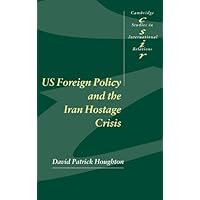
Average Reviews:

(More customer reviews)Raymond Tanter, from Georgetown, said that Houghton, lecturer in government at the University of Essex, has written a case study on the Iran hostage crisis, drawing on the literature of cognitive psychology to explain foreign policy decision-making. The book is fascinating because of the manner in which the author casts his questions--as puzzles to be solved with corresponding solutions. At issue are two questions:
(1) Why did Iranian students, with the tacit support of the Iranian leaders, seize the U.S. embassy in Tehran? Houghton considers several explanations: radical ideology, using the hostages as bargaining chips to get the shah back from the United States, or to prevent a counterrevolution by the United States. Drawing on cognitive psychology, Houghton argues for the third explanation. He then searches for evidence to eliminate competing explanations and marshal support for the idea that students seized the U.S. embassy because they wanted to prevent a repeat of the 1953 outcome when U.S. and British intelligence services stage-managed a coup against Iranian premier Mohammad Mossadeq and reinstalled the shah to power.
(2) Why did President Jimmy Carter choose military force to rescue the hostages, given that his world-view suggested relying exclusively on nonviolent means? He did so because the hostage rescue option was easily retrieved from the memory of Carter's national security team due to two recent experiences, the May 1975 Cambodian seizure of the SS Mayaguez, an American merchant ship (when marines and naval forces captured the ship and the Khmer Rouge government authorized release of the thirty-nine American men of the Mayaguez), as well as the Entebbe, Uganda raid staged by Israeli forces in July 1976. But another case involving the North Korean seizure of a spy ship, the USS Pueblo, in January 1968 was resolved without force, using only diplomatic negotiations (the ship's sailors were returned, but not the ship).
As he does for the Iranian students, Houghton assembles evidence to explain why Carter acted on the basis of the Mayaguez precedent rather than the Pueblo analogy. The Carter administration drew on the Mayaguez precedent because its key officials considered it a successful use of force. In contrast, and despite the return of American hostages without loss of life, they perceived Pueblo as a long-drawn out negotiation without the benefit of reinforcing future U.S. deterrent power or providing domestic gains, such as demonstrating strong leadership qualities by the president.
Houghton, thus, uses the "availability principle" from cognitive psychology to explain both the student seizure and Carter's actions. That said, the explanation for Iranian actions are more persuasive than for U.S. ones. He fails to explain why the Mayaguez incident, with its loss of life, should be a precedent for a president who was indisposed to use force.
Click Here to see more reviews about: US Foreign Policy and the Iran Hostage Crisis (Cambridge Studies in International Relations)
Why did Iranian students seize the American embassy in Tehran in 1979? Why did the Carter administration launch a rescue mission, and why did it fail so spectacularly? This book answers these and other puzzles using an analogical reasoning approach that highlights the role of historical analogies in decision making. Using interviews with key decision makers on both sides, Houghton provides an original analysis of one of the United States' greatest foreign policy disasters of recent years. The book will interest students and scholars of foreign policy analysis and international relations.

No comments:
Post a Comment